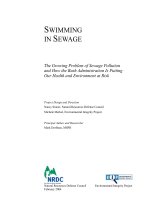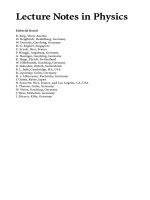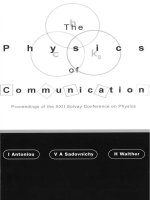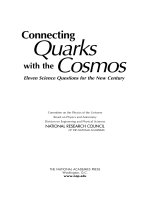- Trang chủ >>
- Khoa Học Tự Nhiên >>
- Vật lý
The quantum age; how the physics of the very small has transformed our lives
Bạn đang xem bản rút gọn của tài liệu. Xem và tải ngay bản đầy đủ của tài liệu tại đây (1.33 MB, 321 trang )
THE
QUANTUM AGE
PHYSICS OF THE VERY SMALL HAS
TRANSFORMED OUR LIVES
HOW THE
BRIAN CLEGG
2
www.pdfgrip.com
Published in the UK in 2014 by
Icon Books Ltd, Omnibus Business Centre,
39–41 North Road, London N7 9DP
email:
www.iconbooks.com
Sold in the UK, Europe and Asia
by Faber & Faber Ltd, Bloomsbury House,
74–77 Great Russell Street,
London WC1B 3DA or their agents
Distributed in the UK, Europe and Asia
by TBS Ltd, TBS Distribution Centre, Colchester Road,
Frating Green, Colchester CO7 7DW
Distributed in South Africa
by Jonathan Ball, Office B4, The District,
41 Sir Lowry Road, Woodstock 7925
Distributed in Australia and New Zealand
by Allen & Unwin Pty Ltd,
PO Box 8500, 83 Alexander Street,
Crows Nest, NSW 2065
Distributed in Canada by
Penguin Books Canada,
90 Eglinton Avenue East, Suite 700,
Toronto, Ontario M4P 2YE
3
www.pdfgrip.com
Distributed to the trade in the USA
by Consortium Book Sales and Distribution
The Keg House, 34 Thirteenth Avenue NE, Suite 101
Minneapolis, Minnesota 55413-1007
ISBN: 978-184831-664-5
Text copyright © 2014 Brian Clegg
The author has asserted his moral rights.
No part of this book may be reproduced in any form, or
by any means, without prior permission in writing from
the publisher.
Typeset in Melior by Marie Doherty
Printed and bound in the UK by Clays Ltd, St Ives plc
4
www.pdfgrip.com
Contents
Acknowledgements
Introduction
1. Enter the quantum
2. Quantum nature
3. The electron’s realm
4. QED
5. Light and magic
6. Super beams
7. Making light work
8. Resistance is futile
9. Floating trains and well-chilled SQUIDs
10. Spooky entanglement
11. From bit to qubit
12. It’s alive!
13. A quantum universe
5
www.pdfgrip.com
Index
6
www.pdfgrip.com
About the author
Science writer Brian Clegg studied physics at Cambridge
University and specialises in making the strangest aspects
of the universe – from infinity to time travel and quantum
theory – accessible to the general reader. He is editor of
www.popularscience.co.uk and a Fellow of the Royal
Society of Arts. His previous books include Inflight
Science, Build Your Own Time Machine, The Universe
Inside You, Dice World and Introducing Infinity: A
Graphic Guide.
www.brianclegg.net
7
www.pdfgrip.com
For Gillian, Chelsea and Rebecca
8
www.pdfgrip.com
Acknowledgements
With thanks as always to my editor, Duncan Heath, for
his help and support, and to all those who have provided
me with information and assistance – you know who you
are.
One person I would like to mention by name is the late
Richard Feynman, whose books enthralled me and who
turned quantum theory from a confusing mystery to an
exciting challenge.
9
www.pdfgrip.com
Introduction
The chances are that most of the time you were at school
your science teachers lied to you. Much of the science,
and specifically the physics, they taught you was rooted
in the Victorian age (which is quite probably why so
many people find school science dull). Quantum theory,
special and general relativity, arguably the most
significant fundamentals of physics, were developed in
the 20th century and yet these are largely ignored in
schools, in part because they are considered too ‘difficult’
and in part because many of the teachers have little idea
about these subjects themselves. And that’s a terrible
pity, when you consider that in terms of impact on your
everyday life, one of these two subjects is quite possibly
the most important bit of scientific knowledge there is.
Relativity is fascinating and often truly mind-boggling,
but with the exception of gravity, which I admit is rather
useful, it has few applications that influence our
experience. GPS satellites have to be corrected for both
special and general relativity, but that’s about it, because
the ‘classical’ physics that predates Einstein’s work is a
very close approximation to what’s observed unless you
travel at close to the speed of light, and is good enough to
deal with everything from the acceleration of a car to
planning a Moon launch. But quantum physics is entirely
different. While it too is fascinating and mind-boggling, it
also lies behind everything. All the objects we see and
touch and use are made up of quantum particles. As is the
10
www.pdfgrip.com
light we use to see those objects. As are you. As is the
Sun and
all the other stars. What’s more, the process that fuels the
Sun, nuclear fusion, depends on quantum physics to
work.
That makes the subject interesting in its own right,
something you really should have studied at school; but
there is far more, because quantum science doesn’t just
underlie the basic building blocks of physics: it is there in
everyday practical applications all around you. It has
been estimated that around 35 per cent of GDP in
advanced countries comes from technology that makes
use of quantum physics in an active fashion, not just in
the atoms that make it up. This has not always been the
case – we have undergone a revolution that just hasn’t
been given an appropriate label yet.
This is not the first time that human beings have
experienced major changes in the way they live as a
result of the development of technology. Historians often
highlight this by devising a technological ‘age’. So, for
instance, we had the stone, bronze and iron ages as these
newly workable materials made it possible to produce
more versatile and effective tools and products. In the
19th century we entered the steam age, when applied
thermodynamics transformed our ability to produce
power, moving us from depending on the basic effort of
animals and the unpredictable force of wind and water to
the controlled might of steam. And though it is yet to be
formally recognised as such, we are now in the quantum
age.
11
www.pdfgrip.com
It isn’t entirely clear when this era began. It is possible to
argue that the use of current electricity was the first use of
true quantum technology, as the flow of electricity
through conductors is a quantum process, though of
course none of the electrical pioneers were aware that this
was the case. If that is a little too concealed a usage to be
a revolution, then there can be no doubt that the
introduction of electronics, a technology that makes
conscious use of quantum effects, meant that we had
moved into a new phase of the world. Since then we have
piled on all sorts of explicitly quantum devices from the
ubiquitous laser to the MRI scanner. Every time we use a
mobile phone, watch TV, use a supermarket checkout or
take a photograph we are making use of sophisticated
quantum effects.
Without quantum physics there would be no matter, no
light, no Sun … and most important, no iPhones.
I’ve already used the word ‘quantum’ thirteen times, not
counting the title pages and cover. So it makes sense to
begin by getting a feel for what this ‘quantum’ word
means and to explore the weird and wonderful science
that lies behind it.
12
www.pdfgrip.com
CHAPTER 1
Enter the quantum
Until the 20th century it was assumed that matter was
much the same on whatever scale you looked at it. When
back in Ancient Greek times a group of philosophers
imagined what would happen if you cut something up
into smaller and smaller pieces until you reached a piece
that was uncuttable (atomos), they envisaged that atoms
would be just smaller versions of what we observe. A
cheese atom, for instance, would be no different, except
in scale, to a block of cheese. But quantum theory turned
our view on its head. As we explore the world of the very
small, such as photons of light, electrons and our modern
understanding of atoms, they behave like nothing we can
directly experience with our senses.
A paradigm shift
Realising the very different reality at the quantum level
was what historians of science like to give the pompous
term a ‘paradigm shift’. Suddenly, the way that scientists
looked at the world became different. Before the quantum
revolution it was assumed that atoms (if they existed at
all – many scientists didn’t really believe in them before
the 20th century) were just like tiny little balls of the stuff
they made up. Quantum physics showed that they
behaved so weirdly that an atom of, say, carbon has to be
treated as if it is something totally different to a piece of
graphite or diamond – and yet all that is inside that
13
www.pdfgrip.com
lump of graphite or diamond is a collection of these
carbon atoms. The behaviour of quantum particles is
strange indeed, but that does not mean that it is
unapproachable without a doctorate in physics. I quite
happily teach the basics of quantum theory to
ten-year-olds. Not the maths, but you don’t need
mathematics to appreciate what’s going on. You just need
the ability to suspend your disbelief. Because quantum
particles refuse to behave the way you’d expect.
As the great 20th-century quantum physicist Richard
Feynman (we’ll meet him again in detail before long)
said in a public lecture: ‘[Y]ou think I’m going to explain
it to you so you can understand it? No, you’re not going
to be able to understand it. Why, then, am I going to
bother you with all this? Why are you going to sit here all
this time, when you won’t be able to understand what I
am going to say? It is my task to persuade you not to turn
away because you don’t understand it. You see, my
physics students don’t understand it either. This is
because I don’t understand it. Nobody does.’
It might seem that Feynman had found a good way to turn
off his audience before he had started by telling them that
they wouldn’t understand his talk. And surely it’s
ridiculous for me to suggest I can teach this stuff to
ten-year-olds when the great Feynman said he didn’t
understand it? But he went on to explain what he meant.
It’s not that his audience wouldn’t be able to understand
what took place, what quantum physics described. It’s
just that no one knows why it happens the way it does.
And because what it does defies common sense, this can
14
www.pdfgrip.com
cause us problems. In fact quantum theory is arguably
easier for
ten-year-olds to accept than adults, which is one of the
reasons I think that it (and relativity) should be taught in
junior school. But that’s the subject of a different book.
As Feynman went on to say: ‘I’m going to describe to
you how Nature is – and if you don’t like it, that’s going
to get in the way of your understanding it … The theory
of quantum electrodynamics [the theory governing the
interaction of light and matter] describes Nature as absurd
from the point of view of common sense. And it agrees
fully with experiment. So I hope you can accept Nature as
she is – absurd.’ We need to accept and embrace the
viewpoint of an unlikely enthusiast for the subject, the
novelist D.H. Lawrence, who commented that he liked
quantum theory because he didn’t understand it.
The shock of the new
Part of the reason that quantum physics proved such a
shocking, seismic shift is that around the start of the 20th
century, scientists were, to be honest, rather smug about
their level of understanding – an attitude they had
probably never had before, and certainly should never
have had since (though you can see it creeping in with
some modern scientists). The hubris of the scientific
establishment is probably best summed up by the words
of a leading physicist of the time, William Thomson,
Lord Kelvin. In 1900 he commented, no doubt in
rounded, selfsatisfied tones: ‘There is nothing new to be
discovered in physics. All that remains is more and more
precise measurement.’ As a remark that he would come
15
www.pdfgrip.com
to bitterly regret this is surely up there with the famous
clanger of Thomas J. Watson Snr, who as chairman of
IBM made the
impressively non-prophetic remark in 1943: ‘I think there
is a world market for maybe five computers.’
Within months of Kelvin’s pronouncement, his certainty
was being undermined by a German physicist called Max
Planck. Planck was trying to iron out a small irritant to
Kelvin’s supposed ‘nothing new’ – a technical problem
that was given the impressive nickname ‘the ultraviolet
catastrophe’. We have all seen how things give off light
when they are heated up. For instance, take a piece of
iron and put it in a furnace and it will first glow red, then
yellow, before getting to white heat that will become
tinged with blue. The ‘catastrophe’ that the physics of the
day predicted was that the power of the light emitted by a
hot body should be proportional to the square of the
frequency of that light. This meant that even at room
temperature, everything should be glowing blue and
blasting out even more ultraviolet light. This was both
evidently not happening and impossible.
To fix the problem, Planck cheated. He imagined that
light could not be given off in whatever-sized amounts
you like, as you would expect if it were a wave. Waves
could come in any size or wavelength – they were
infinitely variable, rather than being broken into discrete
components. (And everyone knew that light was a wave,
just as you were taught at school in the Victorian science
we still impose on our children.)
16
www.pdfgrip.com
Instead, Planck thought, what if the light could come out
only in fixed-sized chunks? This sorted out the problem.
Limit light to chunks and plug it into the maths and you
didn’t get the runaway effect. Planck was very clear – he
didn’t think light actually did come in chunks (or
‘quanta’ as he called them, the plural of the Latin
quantum which roughly means ‘how much’), but it was a
useful trick to make the maths work. Why this was the
case, he had no idea, as he knew that light was a wave
because there were plenty of experiments to prove it.
Mr Young’s experiment
Perhaps the best-known example of these experiments,
and one we will come back to a number of times, is
Young’s slits, the masterpiece of polymath Thomas
Young (1773–1829). This well-off medical doctor and
amateur scientist was obviously remarkable from an early
age. He taught himself to read when he was two,
something his parents discovered only when he asked for
help with some of the longer words in the Bible. By the
time he was thirteen he was a fluent reader in Greek,
Latin, Hebrew, Italian and French. This was a natural
precursor to one of Young’s impressive claims to fame –
he made the first partial translation of Egyptian
hieroglyphs. But his language abilities don’t reflect the
breadth of his interests, from discovering the concept of
elasticity in engineering to producing mortality tables to
help insurance companies set their premiums.
His big breakthrough in understanding light came while
studying the effect of temperature on the formation of
dewdrops – there really was nothing in nature that didn’t
17
www.pdfgrip.com
interest this man. While watching the effect of candlelight
on a fine mist of water droplets he discovered that they
produced a series of coloured rings when the light then
fell on a white screen. Young suspected that this effect
was caused by interactions between waves of light,
proving the wave nature that Christiaan Huygens had
proclaimed back in Newton’s time. By 1801, Young was
ready to prove this with an experiment that has been the
definitive demonstration that light is a wave ever since.
Young produced a sharp beam of light using a slit in a
piece of card and shone this light onto two parallel slits,
close together in another piece of card, finally letting the
result fall on a screen behind. You might expect that each
slit would project a bright line on the screen, but what
Young observed was a series of alternating dark and light
bands. To Young this was clear evidence that light was a
wave. The waves from the two slits were interfering with
each other. When the side-to-side ripples in both waves
were heading in the same direction – say both up – at the
point they met the screen, the result was a bright band. If
the wave ripples were heading in opposite directions, one
up and one down, they would cancel each other out and
produce a dark band. A similar effect can be spotted if
you drop two stones into still water near to each other and
watch how the ripples interact – some waves reinforce,
some cancel out. It is natural wave behaviour.
18
www.pdfgrip.com
Fig. 1. Young’s slits.
It was this kind of demonstration that persuaded Planck
that his quanta were nothing more than a workaround to
make the calculations match what was observed, because
light simply had to be a wave – but he was to be proved
wrong by a man who was less worried about convention
than the older Planck, Albert Einstein. Einstein was to
show that Planck’s idea was far closer to reality than
Planck would ever accept. This discrepancy in viewpoint
was glaringly obvious when Planck recommended
Einstein for the Prussian Academy of Sciences in 1913.
Planck requested the academy to overlook the fact that
Einstein sometimes ‘missed the target in his speculations,
as for example, in his theory of light quanta …’.
The Einstein touch
That ‘speculation’ was made by Einstein in 1905 when he
was a young man of 26 (forget the white-haired icon we
all know: this was a dapper young man-about-town). For
19
www.pdfgrip.com
Einstein, 1905 was a remarkable year in which the
budding scientist, who was yet to achieve a doctorate and
was technically an amateur, came up with the concept of
special relativity,1 showed how Brownian motion2 could
be explained, making it clear that atoms really did exist,
and devised an explanation for the photoelectric effect
(see page 13) that turned Planck’s useful calculating
method into a model of reality.
Einstein was never one to worry too much about fitting
expectations. As a boy he struggled with the rigid nature
of German schooling, getting himself a reputation for
being lazy and uncooperative. By the time he was sixteen,
when most students had little more on their mind than
getting through their exams and getting on with the
opposite sex, he decided that he could no longer tolerate
being a German citizen. (Not that young Albert was the
classic geek in finding it difficult to get on with the girls
– quite the reverse.) Hoping to become a Swiss citizen,
Einstein applied to the exclusive Federal Institute of
Technology, the Eidgenössische Technische Hochschule
or ETH, in Zürich. Certain of his own abilities in the
sciences, Einstein took the entrance exam – and failed.
His problem was a combination of youth and very tightly
focused interests. Einstein had not seen the point of
spending much time on subjects outside the sciences, but
the ETH examination was designed to pick out
allrounders. However, the principal of the school was
impressed by young Albert and recommended he spent a
year in a Swiss secondary school to gain a more
appropriate education. Next year, Einstein applied again
and got through. The ETH certainly allowed Einstein
20
www.pdfgrip.com
more flexibility to follow his dreams than the rigid
German schools, though his headstrong approach made
the head of the physics department, Heinrich Weber,
comment to his student: ‘You’re a very clever boy, but
you have one big fault. You will never allow yourself to
be told anything.’
After graduating, Einstein tried to get a post by writing to
famous scientists, asking them to take him on as an
assistant. When this unlikely strategy failed, he took a
position as a teacher, primarily to be able to gain Swiss
citizenship, as he had already renounced his German
nationality, so was technically stateless. Soon, though, he
would get another job, one that would give him plenty of
time to think. Einstein successfully applied for the post of
Patent Officer (third class) in the Swiss Patent Office in
Bern.
Electricity from light
It was while working there in 1905 that Einstein turned
Planck’s useful trick into the real foundation of quantum
theory, writing the paper that would win him the Nobel
Prize. The subject was the photoelectric effect, the
science behind the solar cells we see all over the place
these days producing electricity from sunlight. By the
early 1900s, scientists and engineers were well aware of
this effect, although at the time it was studied only in
metals, rather than the semiconductors that have made
modern photoelectric cells viable. That the photoelectric
effect occurred was no big surprise. It was known that
light had an electrical component, so it seemed
reasonable that it might be able to give a push to
21
www.pdfgrip.com
electrons3 in a piece of metal and produce a small
current. But there was something odd about the way this
happened.
A couple of years earlier, the Hungarian Philipp Lenard
had experimented widely with the effect and found that it
didn’t matter how bright the light was that was shone on
the metal – the electrons freed from the metal by light of
a particular colour always had the same energy. If you
moved down the spectrum of light, you would eventually
reach a colour where no electrons flowed at all, however
bright the light was. But this didn’t make any sense if
light was a wave. It was as if the sea could only wash
something away if the waves came very frequently, while
vast, towering waves with a low frequency could not
move a single grain of sand.
Einstein realised that Planck’s quanta, his imaginary
packets of light, would provide an explanation. If light
were made up of a series of particles, rather than a wave,
it would produce the effects that were seen. An individual
particle of light4 could knock out an electron only if it
had enough energy to do so, and as far as light was
concerned, higher energy corresponded to being further
up the spectrum. But the outcome had no connection with
the number of photons present – the brightness of the
light – as the effect was produced by an interaction
between a single photon and an electron.
Einstein had not only turned Planck’s useful
mathematical cheat into a description of reality and
explained the photoelectric effect, he had set the
foundation for the whole of quantum physics, a theory
22
www.pdfgrip.com
that, ironically, he would spend much of his working life
challenging. In less than a decade, Einstein’s concept of
the ‘real’ quantum
would be picked up by the young Danish physicist Niels
Bohr to explain a serious problem with the atom. Because
atoms really shouldn’t be stable.
Uncuttable matter
As we have seen, the idea of atoms goes all the way back
to the Ancient Greeks. It was picked up by British
chemist John Dalton (1766–1844) as an explanation for
the nature of elements, but it was only in the early 20th
century (encouraged by another of Einstein’s 1905
papers, the one on Brownian motion) that the concept of
the atom was taken seriously as a real thing, rather than a
metaphorical concept. The original idea of an atom was
that it was the ultimate division of matter – that Greek
word for uncuttable, atomos – but the British physicist
Joseph John Thomson (usually known as J.J.) had
discovered in 1897 that atoms could give off a smaller
particle he called an electron, which seemed to be the
same whatever kind of atom produced it. He deduced that
the electron was a component of atoms – that atoms were
cuttable after all.
The electron is negatively charged, while atoms have no
electrical charge, so there had to be something else in
there, something positive to balance it out. Thomson
dreamed up what would become known as the ‘plum
pudding model’ of the atom. In this, a collection of
electrons (the plums in the pudding) are suspended in a
sort of jelly of positive charge. Originally Thomson
23
www.pdfgrip.com
thought that all the mass of the atom came from the
electrons – which meant that even the lightest atom,
hydrogen, should contain well over a thousand electrons
– but later work suggested that there was mass in the
positive part
of the atom too, and hydrogen, for example, had only the
single electron we recognise today.
Bohr’s voyage of discovery
When 25-year-old physicist Niels Bohr won a scholarship
to spend a year studying atoms away from his native
Denmark he had no doubt where he wanted to go – to
work on atoms with the great Thomson. And so in 1911
he came to Cambridge, armed with a copy of Dickens’
The Pickwick Papers and a dictionary in an attempt to
improve his limited English. Unfortunately he got off to a
bad start by telling Thomson at their first meeting that a
calculation in one of the great man’s books was wrong.
Rather than collaborating with Thomson as he had
imagined, Bohr hardly saw the then star of Cambridge
physics, spending most of his time allocated to his least
favourite activity, undertaking experiments.
Towards the end of 1911, though, two chance meetings
changed Bohr’s future and paved the way for the
development of quantum theory. First, on a visit to a
family friend in Manchester, and again at a ten-course
dinner in Cambridge, Bohr met the imposing New
Zealand physicist Ernest Rutherford, then working at
Manchester University. Rutherford had recently
overthrown the plum pudding model by showing that
most of the atom’s mass was concentrated in a
24
www.pdfgrip.com
positive-charged lump occupying a tiny nucleus at the
heart of the atom. Rutherford seemed a much more
attractive person to work for than Thomson, and Bohr
was soon heading for Manchester.
There Bohr put together his first ideas that would form
the basis of the quantum atom. It might seem natural to
assume that an atom with a (relatively) massive nucleus
and a collection of smaller electrons on the outside was
similar in form to a solar system, with the gravitational
force that keeps the planets in place replaced by the
electromagnetic attraction between the positively charged
nucleus and the negatively charged electrons. But despite
the fact that this picture is still often employed to
illustrate the atom (it’s almost impossible to restrain
illustrators from using it), it incorporates a fundamental
problem. If an electron were to orbit around the nucleus it
would spurt out energy and collapse into the centre,
because an accelerating electrical charge gives off energy
– and to keep in orbit, an electron would have to
accelerate. Yet it was no better imagining that the
electrons were fixed in position. There was no stable
configuration where the electrons didn’t move. This
presented Bohr with a huge challenge.
Inspired by discovering reports of experiments showing
that when heated, atoms gave off light photons of distinct
energies, Bohr suggested something radical. Yes, he
decided, the electrons could be in orbits – but only if
those orbits were fixed, more like railway tracks than the
freely variable orbit of a satellite. And to move between
two tracks required a fixed amount of energy,
corresponding to absorbing or giving off a photon. Not
25
www.pdfgrip.com









